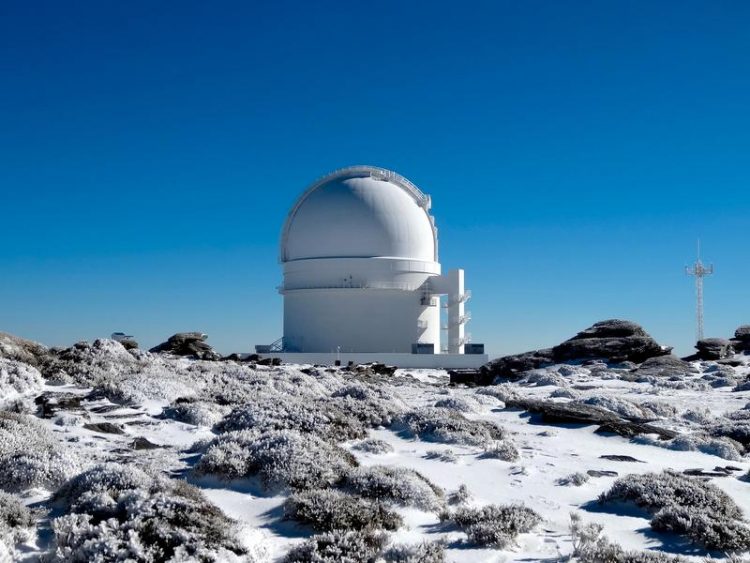Search for planets with Carmenes successful

Dome of the 3.5 m telescope on Calar Alto, Southern Spain, the largest telescope in continental Western Europe. Photo: Carmenes
Since 2016, German and Spanish researchers, among them scientists from the University of Göttingen, have been hunting for exoplanets with the “Carmenes” spectrograph. They now discovered their first star with an exoplanet: The planet is called HD 147379b and is slightly more massive than Neptune. Its star is a so-called M-dwarf only about half as massive as the Sun. The findings were discussed at a Science Meeting in Göttingen and published in Astronomy & Astrophysics.
HD 147379b orbits its star once every 86 days at a distance that is only a third of the distance between Earth and the Sun. At this location, the planet is located inside the so-called habitable zone where water could exist in liquid form. However, it is unlikely that life could develop on this planet because it probably has no solid surface.
“Carmenes is optimized to find planets inside the habitable zones of low-mass stars because this is where we believe the chances that life can develop are highest,” says Professor Ansgar Reiners from Göttingen University’s Institute for Astrophysics. “Finding our first planet right at this place shows that our search for planets in the habitable zone is very efficient.”
Carmenes was planned and built by eleven partners from Germany and Spain, among them the Institute for Astrophysics at Göttingen University. “Carmenes is the first spectrograph that simultaneously looks at optical and infrared light,” explains Professor Stefan Dreizler at the Institute for Astrophysics in Göttingen. “This is an important advantage for the search for planets around low-mass stars.” Carmenes consists of two spectrographs that were optimized for the search for planets around nearby stars.
The project runs at least until 2020. The scientists hope to be able to extend their program beyond this date. “The discovery of an Earth-like planet often requires more than one hundred measurements,” says Göttingen astronomer Dr. Mathias Zechmeister. “We are searching for these planets around hundreds of stars, and for this we need very large amounts of telescope time.” The German Research Foundation (DFG) supports the project through a research unit at the University of Göttingen. Further information can be found online at http://carmenes.caha.es.
Original publication: Reiners, Ribas, Zechmeister et al. HD 147379b: A nearby neptune in the temperate zone of an early M dwarf. Astronomy & Astrophysics 2017. Doi: 10.1051/0004-6361/201732165.
Contact:
Prof. Dr. Ansgar Reiners
University of Göttingen
Faculty of Physics
Institute for Astrophysics
Phone +49 551 39-13825
Email: ansgar.reiners@phys.uni-goettingen.de
Web: http://www.uni-goettingen.de/de/216896.html
Prof. Dr. Stefan Dreizler
University of Göttingen
Faculty of Physics
Institute for Astrophysics
Phone +49 551 39-5041
Email: dreizler@astro.physik.uni-goettingen.de
Web: http://www.uni-goettingen.de/de/216891.html
Media Contact
More Information:
http://www.uni-goettingen.de/All latest news from the category: Physics and Astronomy
This area deals with the fundamental laws and building blocks of nature and how they interact, the properties and the behavior of matter, and research into space and time and their structures.
innovations-report provides in-depth reports and articles on subjects such as astrophysics, laser technologies, nuclear, quantum, particle and solid-state physics, nanotechnologies, planetary research and findings (Mars, Venus) and developments related to the Hubble Telescope.
Newest articles

A universal framework for spatial biology
SpatialData is a freely accessible tool to unify and integrate data from different omics technologies accounting for spatial information, which can provide holistic insights into health and disease. Biological processes…

How complex biological processes arise
A $20 million grant from the U.S. National Science Foundation (NSF) will support the establishment and operation of the National Synthesis Center for Emergence in the Molecular and Cellular Sciences (NCEMS) at…

Airborne single-photon lidar system achieves high-resolution 3D imaging
Compact, low-power system opens doors for photon-efficient drone and satellite-based environmental monitoring and mapping. Researchers have developed a compact and lightweight single-photon airborne lidar system that can acquire high-resolution 3D…





















